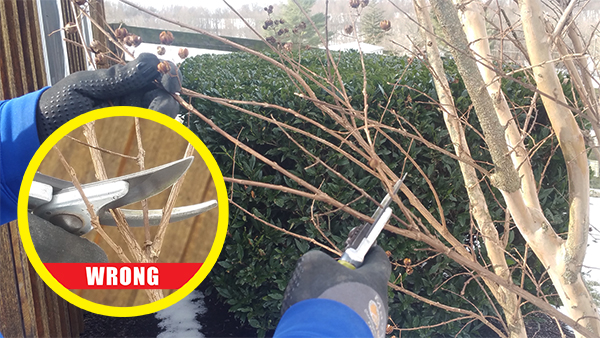Winter Pruning 101
In general the best time to prune is late winter when plants are dormant, just before new growth begins to emerge. Here in the Mid-Atlantic region dormant pruning is usually done six to 10 weeks before the average last frost. Without the leaves, you can easily see the branching structure of the shrub and decide what to cut.
General Cold Weather Pruning Tips
- Avoid late winter pruning shrubs that bloom in the springtime. The best time to prune shrubs that flower early is after it finishes blooming and BEFORE it forms next year’s flower buds.
- Pruning too early in the winter can be detrimental, as newly cut surfaces can dry out if the temperature drops well below freezing.
- Choose a mild, dry day to prune. This will help prevent the spreading of waterborne plant diseases or damage from cold temperatures.
- When pruning, first prune out dead and diseased branches, especially those damaged by the winter’s snow and ice.
- Remove overgrown and smaller branches to increase light and air at the crown of the tree.
- In general, your goal is to keep the branches that develop or maintain the structure of the tree.
- Cut branches at the node, the point at which one branch or twig attaches to another.


Tips on pruning Deciduous Shrubs
- Bushes such as: beautyberry, butterfly bush, clethra, crapemyrtle, panicle hydrangeas (Hydrangea paniculata), smooth hydrangeas (Hydrangea arborescens), roses, and rose of Sharon are safe to prune in the late winter. Spring flowering shrubs (those that bloom before Mid-June) should be pruned after flowering.
- Shape barberry, dogwood, and deciduous holly as needed.
- Wisteria: prune shoots down to three to five buds to encourage better blooming.

Tips on pruning Hedges
- Formal hedges often require both a winter and mid-summer shaping, including plants like abelia, arborvitae, boxwood, euonymus, holly, and juniper.
Tips on pruning Evergreens
- Prune most broadleaf evergreens now: abelia, boxwood, cleyera, elaeagnus, nandina, and holly. Wait until after flowering for spring bloomers.
- Viburnums (both evergreen and deciduous) can be cut back hard to reduce size, but you will sacrifice flowers for the season. Wait until after flowering for light pruning.
- Needled evergreens including arborvitae, juniper, and yews can be shaped in late winter. Take care not to cut back into old wood. Cone-bearing evergreens are pruned in June.
- Unwanted lower branches on all evergreen shrubs and trees should also be removed in late winter.
February 24, 2021












